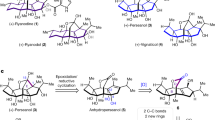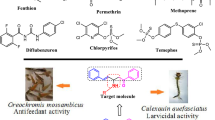Abstract
RECENT work1 has indicated that mevalonic acid (I) is an intermediate in the biosynthesis of terpenoid compounds. We now wish to report some experiments which indicate that this acid is also involved in the biosynthesis of the ‘pyrethrins’, the insecticidal constituents of the pyrethrum plant, Chrysanthemum cinerariaefolium. The ‘pyrethrins’ are a mixture of four closely related esters2 derived from two acids, chrysanthemum monocarboxylic acid (II, R = —Me) and pyrethric acid (II, R = —COOMe), and two keto-alcohols, pyrethrolone (III, R = —CH = CH2) and cinerolone (III, R = —CH3). It is customary to refer to the mixture of the two esters derived from chrysanthemum monocarboxylic acid and the keto-alcohols as ‘pyrethrin I’ and to that from pyrethric acid as ‘pyrethrin II’. The two acids have carbon skeletons which can be built up from two isoprene units, and thus might be expected to be derived from mevalonic acid. The two keto-alcohols cannot be so regarded, but it is of interest to note that the methylpentenone ring could be formed in theory by the cyclization of mevalonic acid. We have now shown that this theoretically attractive route is not employed by the plant.
This is a preview of subscription content, access via your institution
Access options
Subscribe to this journal
Receive 51 print issues and online access
$199.00 per year
only $3.90 per issue
Buy this article
- Purchase on Springer Link
- Instant access to full article PDF
Prices may be subject to local taxes which are calculated during checkout
Similar content being viewed by others
References
Ciba Foundation Symp. Biosynth. Terpenes and Sterols (Churchill, London, 1951).
Harper, S. H., Ann. Rep. Prog. Chem., 45, 162 (1948).
Martin, J. T., and Tattersfield, F., Ann. App. Biol., 21, 670 (1934).
Purcell, H. E., Thompson, G. H., and Bonner, J., J. Biol. Chem., 234, 1081 (1959).
Chandler, S. E., Pyrethrum Post, 4 (1), 10 (1956).
Spickett, R. G. W., Chem. and Indust., 561 (1957).
Moore, B. P., J. Sci. Food Agric., 7, 740 (1956).
Elliott, M., Chem. and Indust., 685 (1958).
Cornforth, R. H., Fletcher, K., Hellig, H., and Popják, G., Nature, 185, 923 (1960).
Birch, A. J., Blance, G. E., and Smith, H., J. Chem. Soc., 4582 (1958).
Eggerer, H., and Lynen, F., Liebigs Ann., 608, 71 (1957).
Durr, J. F., and Rudney, H., J. Biol. Chem., 235, 2572 (1960).
Author information
Authors and Affiliations
Rights and permissions
About this article
Cite this article
CROWLEY, M., INGLIS, H., SNAREY, M. et al. Biosynthesis of the Pyrethrins. Nature 191, 281–282 (1961). https://doi.org/10.1038/191281a0
Issue Date:
DOI: https://doi.org/10.1038/191281a0
This article is cited by
-
Pyrethrin from Dalmatian pyrethrum (Tanacetum cinerariifolium (Trevir.) Sch. Bip.): biosynthesis, biological activity, methods of extraction and determination
Phytochemistry Reviews (2021)
-
Partial sequence isolation of DXS and AOS genes and gene expression analysis of terpenoids and pyrethrin biosynthetic pathway of Chrysanthemum cinerariaefolium under abiotic elicitation
Acta Physiologiae Plantarum (2020)
Comments
By submitting a comment you agree to abide by our Terms and Community Guidelines. If you find something abusive or that does not comply with our terms or guidelines please flag it as inappropriate.



